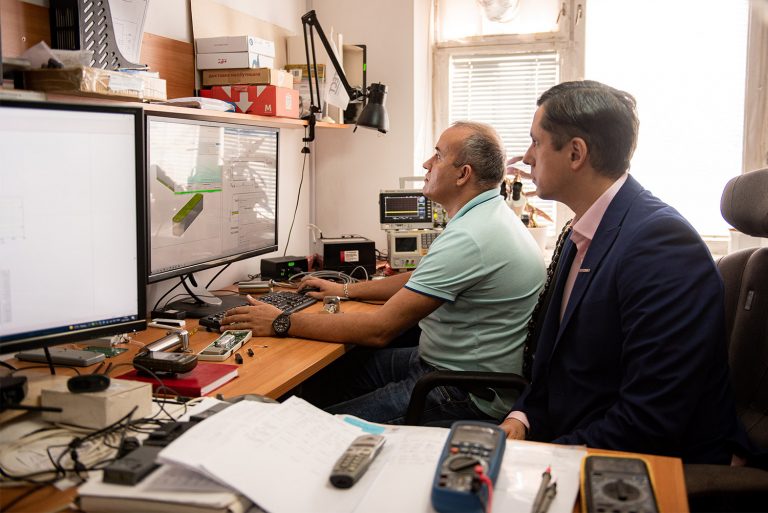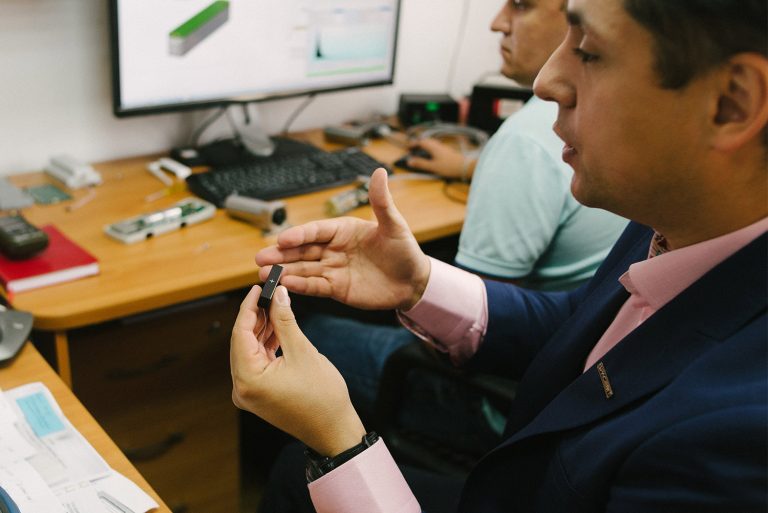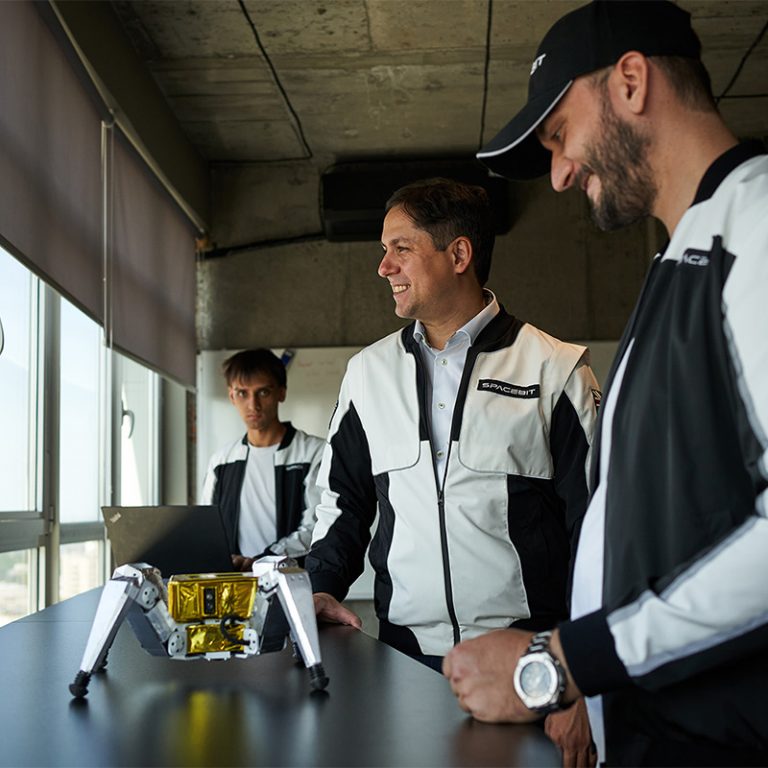Almost half a century after the “giant leap for mankind”, earthlings are once again conquering the Moon. Within this decade, the first woman and man are planned to land on Earth’s satellite, which will be preceded by numerous studies, analyses, and lunar rover expeditions. Thanks to the British company Spacebit and its Ukrainian founder, Pavlo Tanasiuk, Ukraine will become a participant in this big space event.
The first lunar rover on its feet, developed by the Spacebit team, has merged the efforts of several countries. Ukrainian specialists were asked for help in studying the radiation background of the Moon and to develop software for the lunar rover. The results of their common work will affect not only the success of the British mission, but also the future study and exploration of the Moon.
How Ukraine’s space potential was born
The space history of Ukraine began in the 1920s with the scientific works of Yurii Kondratiuk (real name is Oleksandr Sharhei), in which he outlined the ideas of astronautics — the theory of space flight — and calculated optimal trajectories to the Moon and back. After Yurii Kondratiuk, there were a number of outstanding Ukrainian scientists in the field of astronautics and rocket science. Among them were Serhii Koroliov and Valentyn Hlushko, developers of the first artificial Earth satellite launched on October 4, 1957.
After the Second World War, rocket and space industry enterprises appeared in major cities of the Ukrainian SSR (“Hartron” in Kharkiv, “Pivdenne” Design Bureau in Dnipro), and space departments were added to a number of machine-building and radio plants (“Arsenal” plant in Kyiv and plant of radio devices in Chernihiv).
Behind the rapid development of enterprises and space achievements of the USSR, the destroyed destinies of the aforementioned scientists and engineers were hidden. They were sentenced for so-called political crimes, but in fact they were sentenced for their Ukrainian identity, which they openly spoke about. They were sent into exile, and at best, they were sent to “sharashky” — secret research institutes or bureaus attached to factories where they continued to work under the supervision of security agencies.

With the resumption of Ukraine’s independence in 1991, the Ukrainian space industry is gradually falling into disrepair, as after the collapse of the USSR, the country went through a difficult stage of economic and political formation. Attention was paid to this area only at the very start of independence (1993-1997): the government adopted a state space program aimed at preserving the space heritage of previous years, to gradually enter the international market, and to provide funding for the implementation of the set tasks. During this period, independent Ukraine launched its first satellite, “Sich-1”, and dozens of launch vehicles. Not to mention, in 1997, Ukrainian cosmonaut Leonid Kadeniuk flew into space as part of the American Space Shuttle program, where, together with other scientists, he studied the effect of weightlessness on plant development.
After 2014, when Ukraine decided on a geopolitical direction at the state level, Ukrainian space enterprises are more involved in foreign missions than in domestic projects. Furthermore, due to legislative constraints, only state institutions with insufficient funds to fully function could work in Ukraine’s space industry until recently.
In 2021, the government allowed private companies to work in the space industry. Until then, due to unfavorable conditions for private space research, Ukrainian entrepreneurs had been looking for opportunities in Europe and the United States, which is the case with with Pavlo Tanasiuk, the founder of the British company Spacebit.

Pavlo Tanasiuk. Spacebit
It seems that the theme of space has accompanied Pavlo Tanasiuk since his childhood. He was born and raised in Zhytomyr on Kosmonavty street, so he knew very well who Serhii Koroliov was. The young Tanasiuk dreams of space did not disappear with age but instead they turned into goals. First, he received an economic education: after Kyiv University, he received a master’s degree at the London School of Economics and the Cambridge University Business School, and then he started his first business, the completion of which gave rise to a cosmic stage in Pavlo’s life.
“The story is a little similar to Elon Musk’s when he sold PayPal and then engaged in the space sphere. We had the first payment system in Ukraine — MoneXy. After we sold it, we started investing in space business. That is, it was money that I earned on the exit poll (here in the sense of “selling a share” — ed.) of my business.”
In 2014, together with four like-minded people from the University of Cambridge, Pavlo Tanasiuk founded Spacebit, a company that works on technologies for exploring and familiarizing with the Moon. The company’s first project was related to the founder’s previous experience. The team planned to launch the first blockchain system through which anyone could invest in space activities. This idea was never implemented, but Pavlo believes that sooner or later space, in particular the Moon, will become available to the public.
Blockchain
A continuous chain of blocks built according to certain rules, which contain information and are stored on many different computers of independent users.“I believe in the future potential of space commercialization. I believe that people will have production not only on Earth but also in space. In the future, people will travel to space as tourists or as people who work there. It won’t be something special, it will become part of the Earth’s ecosystem.”
To bring this moment closer, Spacebit has chosen the area of lunar exploration. Now the team consists of about 30 participants from different parts of the world for example Japan, Great Britain, Luxembourg, and Poland. They are preparing for the first British mission to the Moon, which will contribute to the exploration of the Earth’s satellite.

Asagumo. Mission to the Moon
More than 50 years after the first human Moon landing, the American National Aeronautics and Space Administration (NASA) plans to repeat the mission, sending the first woman and man under the Artemis program within the decade. To ensure a successful landing and stay on the Moon, they will first launch lunar rovers and special sensors to examine the properties of the surface and atmosphere.
Spacebit will participate in the research part of the program.
“This will be the first device made in the UK that will be delivered specifically to the surface of the Moon. Interestingly, our lunar rover, which we are developing, does not have wheels, but legs. That is, the rover will be the first device in the history of mankind that will take a step (on the Moon).”
Similar to a spider robot, the Asagumo lunar rover, which means “morning clouds” in Japanese, consists of a “box” (a cubic base) and four legs. This model is determined by the landscape in which the lunar rover will move. Asagumo’s mission is to explore lava caves on the Moon that can become a potential refuge for humans.
“Once the Moon station is built, we will need to know whether we’re doing it from regolith (on the principle of building blocks. — ed.) or whether we can put people in this cave, close the entrance, and create an atmosphere in which they can live.”
Regolith
Lunar soil consisting of heterogeneous formations (dust and fragments of various lunar rocks).The Spacebit lunar rover will measure indicators such as radiation levels and temperature on the lunar surface. Pavlo Tanasiuk says that, in addition to scientific significance, these data will have great commercial value. In other words, Spacebit will be able to sell information to companies that plan to carry out missions and develop infrastructure on the Moon.
The flight of the Asagumo robot is scheduled for 2022. The British company has booked seats in advance on two lander modules of the American private companies Astrobotic and Intuitive Machines, which deliver research vehicles to the Earth’s satellite. In turn, the lander will go into space on SpaceX and ULA rockets. Pavlo says that getting permission for a seat in the rocket is not so easy — however, money is not the issue.
“There are a number of requirements regarding what materials the robot should be created from, how it functions, and whether there are any plastics that produce gases. Or maybe it will explode if there are problems with the battery. There is a requirement that other equipment should not be damaged. There are also vibration tests and radiation tests that we must pass. Then there is testing in a hot vacuum chamber.”
Only after all these tests are successfully passed, the robot is taken on board and flies to the Moon.
The lander module is important not only for transporting the lunar rover, but also for transmitting its collected data. Asagumo will first transmit all measurements and photos of the module via Wi-Fi, and it will send data to the Earth in the flight control room, which will be located in Kyiv. Pavlo chose the place of data reception not by chance, but because the sensor for measuring the level of radiation on the lunar rover was produced in Ukraine. So the British mission to the Moon is gradually becoming British-Ukrainian.

First Ukrainian mission to the Moon
Ukraine joined the development of missions to the Moon back in Soviet times. In a constant space race with the United States, the Soviet Union sought to conquer the Moon first. To do this, the government, together with the Serhii Koroliov design bureau, developed a program that consisted of five stages: flying around the Moon, installing a lunar rover, landing a person on the Moon, remote research of the Earth’s satellite, and creating a manned lunar station. Unfortunately, the program was not implemented due to poor coordination of processes, but one Soviet lunar rover still rode on the lunar surface on wheels manufactured at the Kharkiv bicycle factory.
Taking into account the successful space developments of Ukrainian engineers, Pavlo Tanasiuk decided to look for partners in his homeland to carry out the mission. The first to join the project was the Pivdenne Design Bureau in Dnipro, known for such developments as the Zenit rocket and space complex and the first Ukrainian Sich-1 and Sich-2 satellites.
“We met the Pivdenne Design Bureau team at an aerospace conference in France and somehow started talking and collaborating together. They help us test our robot. These are vibration studies and studies in a vacuum chamber. Also, some parts will be produced by the Pivdenne Design Bureau.”


slideshow
The next successful collaboration was working with a Lviv-based company which develops radiation monitoring systems called “Sparring-Whist Center”. They developed a radiation sensor for the lunar rover Asagumo. According to Yaroslav Votus, director of business development and marketing, the company produces radiation monitoring equipment and pyrotechnic products under the Ecotest trademark for Ukrainian and foreign customers, including the Ministry of Defense of Ukraine and NATO troops. Their sensors were used after the disaster at the Fukushima nuclear power plant in Japan. Then the company was faced with the task of developing radiation sensors for the aquatic environment. Pavlo’s request was even more difficult because conditions on the Moon require the smallest size and a high level of sensor protection.
“The difference in temperature on the Moon is very large (at night, it is an estimated -170°C and during the day it is about +130°C). This is why housing will protect us from the difference in temperature. And then, of course, it’s protection from the external environment. There is a lot of fine and dispersed dust on the Moon, so it can penetrate very small cracks, and that is why it is very important to make this device sealed.”
Yaroslav admits that this is a real challenge for developers, but many years of experience and the importance of this mission give them confidence:
“There are commercial projects, and this is a project that is for the future. These are things that are carried out with a certain feeling. This is the work we do to pass on knowledge to the next generation. That is, when Pavlo came to us and said that a sensor was needed, we had no doubt that we would create it.”
In addition, the Ukrainian company has the results of numerous studies on the Chernobyl disaster in 1986 and can test its devices in areas with high radiation levels.
Before sending the Asagumo lunar rover, a probe will fly to the Moon — a static device that will be located above the surface of the Moon. It will take photos and measure radiation levels. In addition to the Sparring-Whist Center and Pivdenne Design Bureau, the Meridian plant in Kyiv named after S. P. Koroliov and the Dnipro company for the production of titanium products called “TitanEra” are working on this probe. As part of the first mission, a titanium flag of Ukraine will be installed on the moon in memory of the state’s contribution to International Space Activities.

No one can predict what results either mission will yield, but this is a big event for the UK and Ukraine. Pavlo returned to his starting point, Ukraine, to revive its potential in astronautics, which the country used to be well-known for. In his opinion, countries cannot work in space alone, as it was before, so the British company Spacebit will later open a branch in Ukraine to unite the forces of two potentially strong countries.
“I believe that due to the intersection of different cultures and the intersection of different technologies, we can make some interesting inventions. That is, projects like these unites different talents. For example, in the UK they develop electronics better, and we (in Ukraine) have the best programmers. Why don’t they work together to create a satellite?”
supported by
The project “Anthropological and ethnographic expedition by Ukraїner: Ukrainians in Great Britain” is realized within the program “Culture for change” with the support of the Ukrainian Cultural Fund (Ukraine) and the British Council (Great Britain). Ukraїner is responsible for the content of this multimedia story, which might not represent the official position of the Ukrainian Cultural Fund and the British Council.


